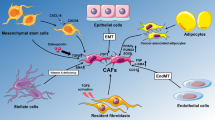Abstract
Cancer-associated fibroblasts (CAFs) — mesenchymal cells in the tumor stroma, play one of the leading roles in tumor progression in many different tumors, including colorectal cancer. Scientists have described many markers for CAFs, but none of them is specific. We performed immunohistochemistry tests using five antibodies (αSMA, POD, FAP, PDGFRα, PDGFRβ) to investigate CAFs in three zones of 49 colorectal adenocarcinomas: apical, central, and invasive edge. We revealed the reliable correlation between high PDGFRβ and PDGFRα value in the apical zone and deeper invasion (T3–T4) (p = 0.0281 and p = 0.0137). High αSMA level in apical zone (p = 0.0001), αSMA level in central zone (p = 0.019), POD level in apical zone (p = 0.0222), POD level in central zone (p = 0.0206) and PDGFRβ level in apical zone (p = 0.014) correlated reliably with the presence of metastasis in lymphatic nodules. For the first time, focused on the inner layer of CAF adjacent to tumor complexes. We observed that cases with inner αSMA expression were significantly more often (p = 0.023) characterized by the presence of regional lymph node metastasis compared with cases with mix of CAF markers (p = 0.007) and with cases with inner POD expression (p = 0.024). The found relationships between the level of markers and the presence of metastases indicate their clinical significance.



Similar content being viewed by others
References
Kalluri R (2016) The biology and function of fibroblasts in cancer. Nat Rev Cancer 16(9):582–598. https://doi.org/10.1038/nrc.2016.73
Koliaraki V, Prados A, Armaka M, Kollias G (2020) The mesenchymal context in inflammation, immunity and cancer. Nat Immunol 21(9):974–982. https://doi.org/10.1038/s41590-020-0741-2
Biffi G, Tuveson DA (2021) Diversity and biology of cancer-associated fibroblasts. Physiol Rev 101(1):147–176. https://doi.org/10.1152/physrev.00048.2019
Berdiel-Acer M, Sanz-Pamplona R, Calon A et al (2014) Differences between CAFs and their paired NCF from adjacent colonic mucosa reveal functional heterogeneity of CAFs, providing prognostic information. Mol Oncol 8(7):1290–1305. https://doi.org/10.1016/j.molonc.2014.04.006
Nishishita R, Morohashi S, Seino H et al (2018) Expression of cancer-associated fibroblast markers in advanced colorectal cancer. Oncol Lett 15(5):6195–6202. https://doi.org/10.3892/ol.2018.8097
Sandberg TP, Stuart M, Oosting J et al (2019) Increased expression of cancer-associated fibroblast markers at the invasive front and its association with tumor-stroma ratio in colorectal cancer. BMC Cancer 19(1):284. https://doi.org/10.1186/s12885-019-5462-2
Dumont N, Liu B, Defilippis RA et al (2013) Breast fibroblasts modulate early dissemination, tumorigenesis, and metastasis through alteration of extracellular matrix characteristics. Neoplasia 15(3):249–262. https://doi.org/10.1593/neo.121950
Ishii G, Ochiai A, Neri S (2016) Phenotypic and functional heterogeneity of cancer-associated fibroblast within the tumor microenvironment. Adv Drug Deliv Rev 99(Pt B):186–196. https://doi.org/10.1016/j.addr.2015.07.007
Ozdemir BC, Pentcheva-Hoang T, Carstens JL et al (2014) Depletion of carcinoma-associated fibroblasts and fibrosis induces immunosuppression and accelerates pancreas cancer with reduced survival. Cancer Cell 25(6):719–734. https://doi.org/10.1016/j.ccr.2014.04.005
WHO Classification of Tumors (2019) Digestive system tumors, 5th edn. WHO Press, Switzerland
Oleynikova N, Malkov P, Danilova N. (2020). Changes in the classification of malignant colon epithelial neoplasms. (WHO, 2019, 5th edition). Arkhiv Patologii 82(3), 38–46. https://doi.org/10.17116/patol20208203138
Oe S, Hasegawa K, Nagase S et al (2010) Expression of podoplanin in epithelial ovarian carcinomas and its potential as a marker for clear cell adenocarcinoma. Int J Gynecol Pathol Off J Int Soc Gynecol Pathol 29(5):405–410. https://doi.org/10.1097/PGP.0b013e3181d3261e
Kubouchi Y, Yurugi Y, Wakahara M et al (2018) Podoplanin expression in cancer-associated fibroblasts predicts unfavourable prognosis in patients with pathological stage IA lung adenocarcinoma. Histopathology 72(3):490–499. https://doi.org/10.1111/his.13390
Yamanashi T, Nakanishi Y, Fujii G et al (2009) Podoplanin expression identified in stromal fibroblasts as a favorable prognostic marker in patients with colorectal carcinoma. Oncology 77(1):53–62. https://doi.org/10.1159/000226112
Choi SY, Sung R, Lee SJ et al (2013) Podoplanin, alpha-smooth muscle actin or S100A4 expressing cancer-associated fibroblasts are associated with different prognosis in colorectal cancers. J Korean Med Sci 28(9):1293–1301. https://doi.org/10.3346/jkms.2013.28.9.1293
Kilvaer TK, Rakaee M, Hellevik T et al (2019) Differential prognostic impact of platelet-derived growth factor receptor expression in NSCLC. Sci Rep 9(1):10163. https://doi.org/10.1038/s41598-019-46510-3
Funding
We thank all the participants for their contribution to the study. This work was sponsored by Russian Foundation for Basic Research (RFBR, grant «Perspektiva» № 19-315-60006) and was carried out using equipment purchased under the development program of the Lomonosov Moscow State University until 2021.
Author information
Authors and Affiliations
Contributions
Nina Alexandrovna Oleynikova, MD, PhD — Conceptualization, Data Curation, Investigation, Methodology, Project Administration, Validation, Visualization
Ilya Alexandrovich Mikhailov, graduate student — Formal Analysis, Review & Editing
Timofey Yurevich Zavidnyi, student — Data Curation, Investigation, Writing (Original Draft Preparation)
Nataliya Vladimirovna Danilova, MD, PhD — Resources, Visualization, Review & Editing
Olga Andreevna Kharlova, MD, PhD — Funding Acquisition, Resources
Pavel Georgievich Malkov, MD, PhD, Professor — Project Administration, Software, Supervision
Corresponding author
Additional information
Publisher's Note
Springer Nature remains neutral with regard to jurisdictional claims in published maps and institutional affiliations.
Rights and permissions
Springer Nature or its licensor holds exclusive rights to this article under a publishing agreement with the author(s) or other rightsholder(s); author self-archiving of the accepted manuscript version of this article is solely governed by the terms of such publishing agreement and applicable law.
About this article
Cite this article
Oleynikova, N.A., Mikhailov, I.A., Kharlova, O.A. et al. Detection, Role and Prognostic Value of Cancer-associated Fibroblasts in Colorectal Cancer. Indian J Surg Oncol 14, 186–193 (2023). https://doi.org/10.1007/s13193-022-01653-0
Received:
Accepted:
Published:
Issue Date:
DOI: https://doi.org/10.1007/s13193-022-01653-0




